Cooperative Strategy: IKEA India's Approach
VerifiedAdded on 2023/06/06
|11
|2980
|57
AI Summary
This report analyzes the cooperative strategies used by IKEA India to increase customer satisfaction and sales. It also evaluates the dynamics of the target market and the company's use of co-operative strategy with suppliers.
Contribute Materials
Your contribution can guide someone’s learning journey. Share your
documents today.
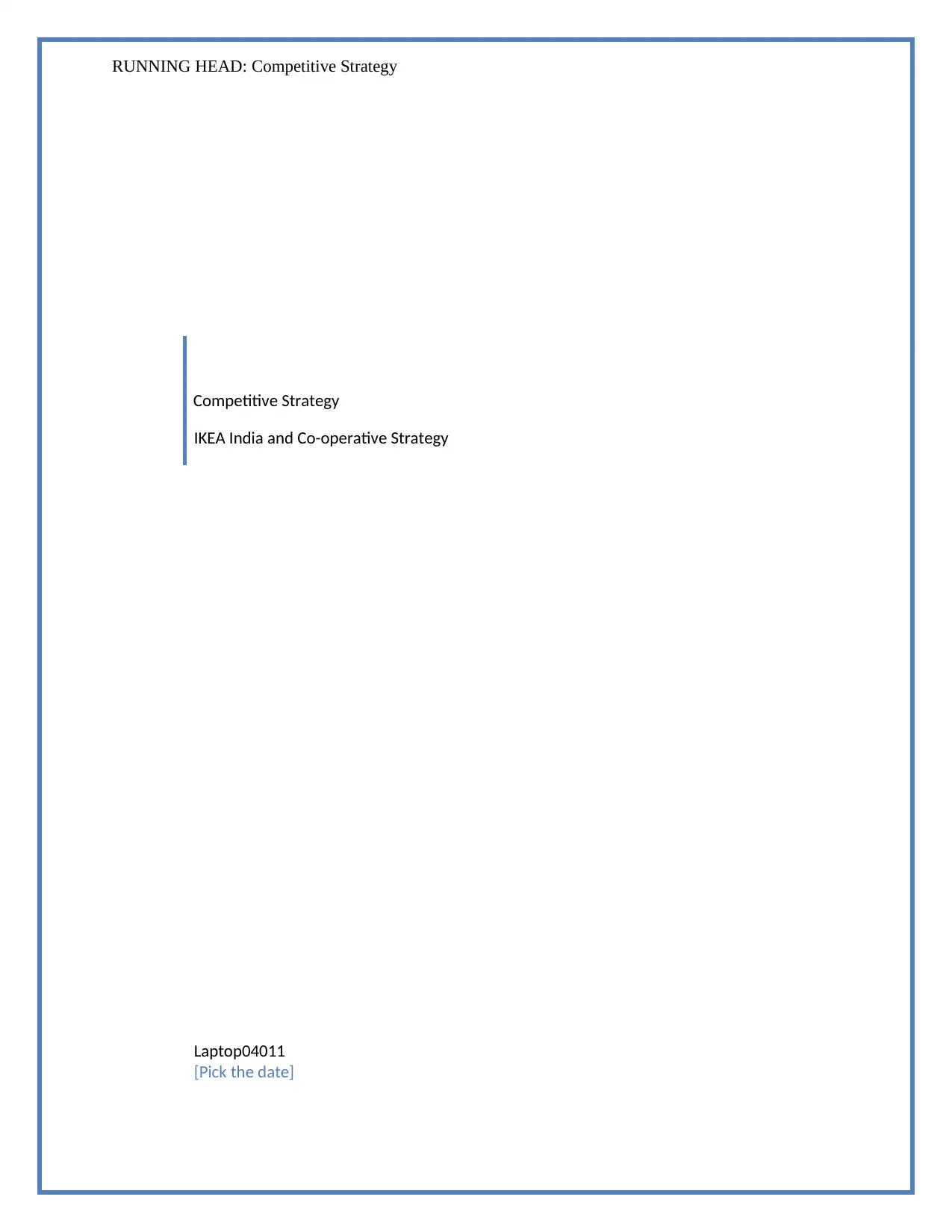
RUNNING HEAD: Competitive Strategy
Competitive Strategy
IKEA India and Co-operative Strategy
Laptop04011
[Pick the date]
Competitive Strategy
IKEA India and Co-operative Strategy
Laptop04011
[Pick the date]
Secure Best Marks with AI Grader
Need help grading? Try our AI Grader for instant feedback on your assignments.
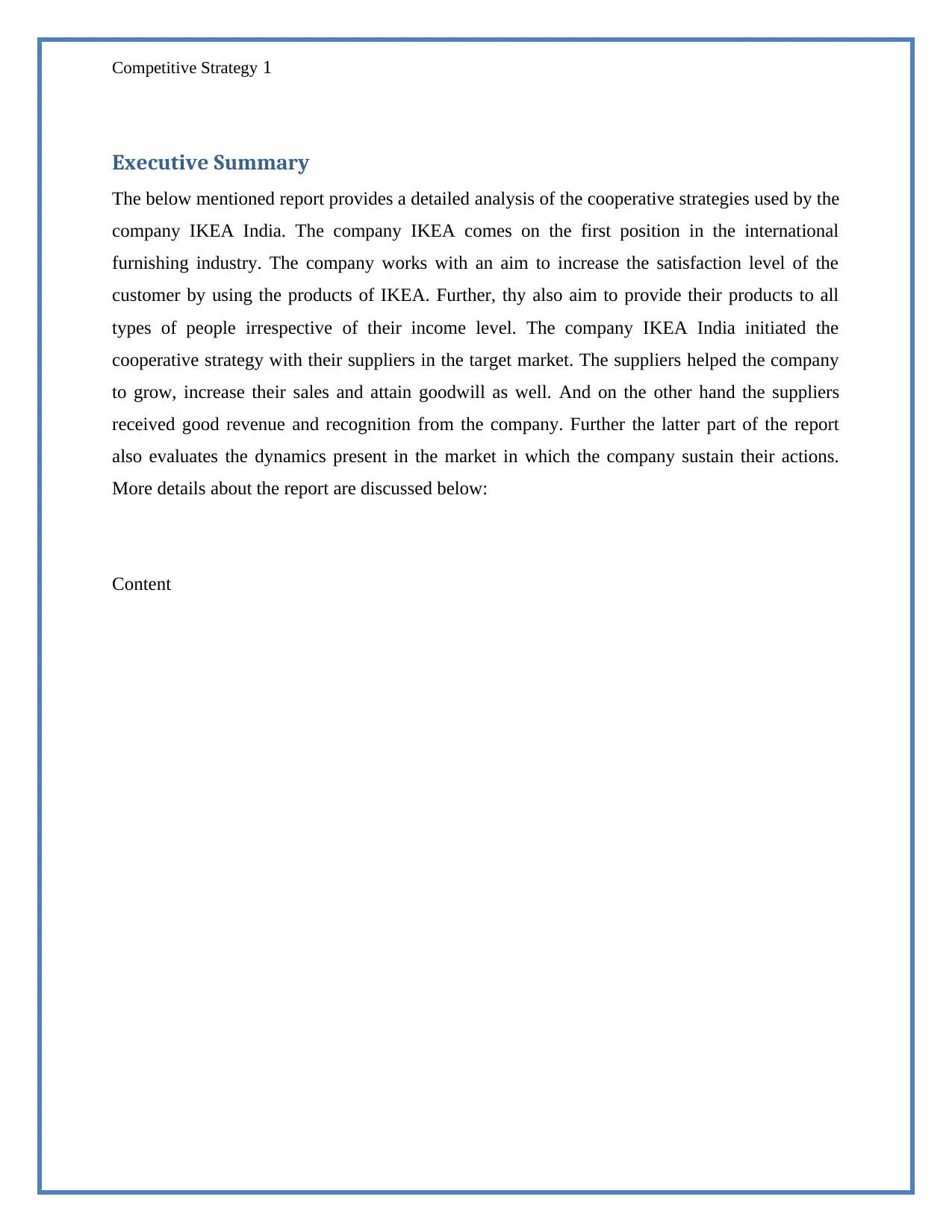
Competitive Strategy 1
Executive Summary
The below mentioned report provides a detailed analysis of the cooperative strategies used by the
company IKEA India. The company IKEA comes on the first position in the international
furnishing industry. The company works with an aim to increase the satisfaction level of the
customer by using the products of IKEA. Further, thy also aim to provide their products to all
types of people irrespective of their income level. The company IKEA India initiated the
cooperative strategy with their suppliers in the target market. The suppliers helped the company
to grow, increase their sales and attain goodwill as well. And on the other hand the suppliers
received good revenue and recognition from the company. Further the latter part of the report
also evaluates the dynamics present in the market in which the company sustain their actions.
More details about the report are discussed below:
Content
Executive Summary
The below mentioned report provides a detailed analysis of the cooperative strategies used by the
company IKEA India. The company IKEA comes on the first position in the international
furnishing industry. The company works with an aim to increase the satisfaction level of the
customer by using the products of IKEA. Further, thy also aim to provide their products to all
types of people irrespective of their income level. The company IKEA India initiated the
cooperative strategy with their suppliers in the target market. The suppliers helped the company
to grow, increase their sales and attain goodwill as well. And on the other hand the suppliers
received good revenue and recognition from the company. Further the latter part of the report
also evaluates the dynamics present in the market in which the company sustain their actions.
More details about the report are discussed below:
Content
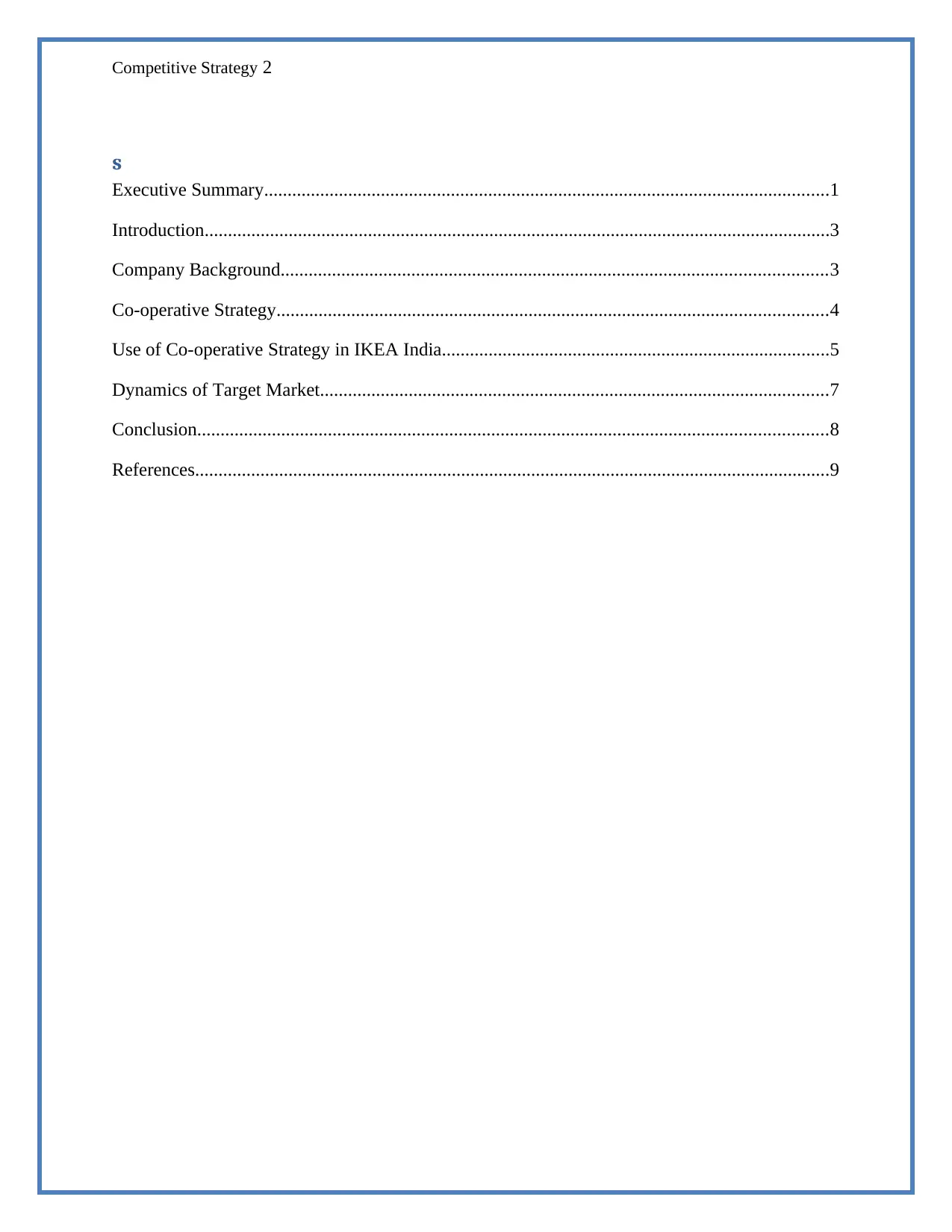
Competitive Strategy 2
s
Executive Summary.........................................................................................................................1
Introduction......................................................................................................................................3
Company Background.....................................................................................................................3
Co-operative Strategy......................................................................................................................4
Use of Co-operative Strategy in IKEA India...................................................................................5
Dynamics of Target Market.............................................................................................................7
Conclusion.......................................................................................................................................8
References........................................................................................................................................9
s
Executive Summary.........................................................................................................................1
Introduction......................................................................................................................................3
Company Background.....................................................................................................................3
Co-operative Strategy......................................................................................................................4
Use of Co-operative Strategy in IKEA India...................................................................................5
Dynamics of Target Market.............................................................................................................7
Conclusion.......................................................................................................................................8
References........................................................................................................................................9
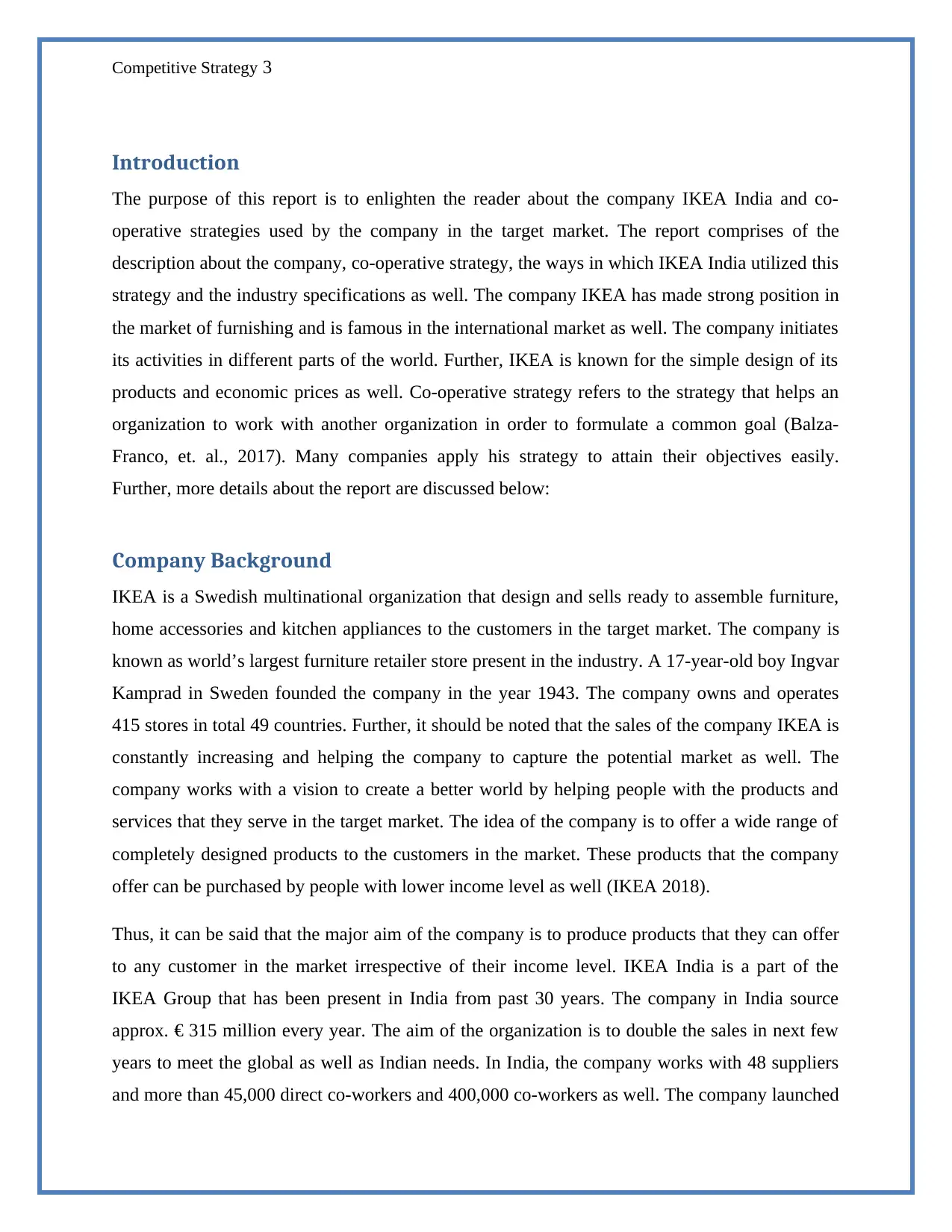
Competitive Strategy 3
Introduction
The purpose of this report is to enlighten the reader about the company IKEA India and co-
operative strategies used by the company in the target market. The report comprises of the
description about the company, co-operative strategy, the ways in which IKEA India utilized this
strategy and the industry specifications as well. The company IKEA has made strong position in
the market of furnishing and is famous in the international market as well. The company initiates
its activities in different parts of the world. Further, IKEA is known for the simple design of its
products and economic prices as well. Co-operative strategy refers to the strategy that helps an
organization to work with another organization in order to formulate a common goal (Balza-
Franco, et. al., 2017). Many companies apply his strategy to attain their objectives easily.
Further, more details about the report are discussed below:
Company Background
IKEA is a Swedish multinational organization that design and sells ready to assemble furniture,
home accessories and kitchen appliances to the customers in the target market. The company is
known as world’s largest furniture retailer store present in the industry. A 17-year-old boy Ingvar
Kamprad in Sweden founded the company in the year 1943. The company owns and operates
415 stores in total 49 countries. Further, it should be noted that the sales of the company IKEA is
constantly increasing and helping the company to capture the potential market as well. The
company works with a vision to create a better world by helping people with the products and
services that they serve in the target market. The idea of the company is to offer a wide range of
completely designed products to the customers in the market. These products that the company
offer can be purchased by people with lower income level as well (IKEA 2018).
Thus, it can be said that the major aim of the company is to produce products that they can offer
to any customer in the market irrespective of their income level. IKEA India is a part of the
IKEA Group that has been present in India from past 30 years. The company in India source
approx. € 315 million every year. The aim of the organization is to double the sales in next few
years to meet the global as well as Indian needs. In India, the company works with 48 suppliers
and more than 45,000 direct co-workers and 400,000 co-workers as well. The company launched
Introduction
The purpose of this report is to enlighten the reader about the company IKEA India and co-
operative strategies used by the company in the target market. The report comprises of the
description about the company, co-operative strategy, the ways in which IKEA India utilized this
strategy and the industry specifications as well. The company IKEA has made strong position in
the market of furnishing and is famous in the international market as well. The company initiates
its activities in different parts of the world. Further, IKEA is known for the simple design of its
products and economic prices as well. Co-operative strategy refers to the strategy that helps an
organization to work with another organization in order to formulate a common goal (Balza-
Franco, et. al., 2017). Many companies apply his strategy to attain their objectives easily.
Further, more details about the report are discussed below:
Company Background
IKEA is a Swedish multinational organization that design and sells ready to assemble furniture,
home accessories and kitchen appliances to the customers in the target market. The company is
known as world’s largest furniture retailer store present in the industry. A 17-year-old boy Ingvar
Kamprad in Sweden founded the company in the year 1943. The company owns and operates
415 stores in total 49 countries. Further, it should be noted that the sales of the company IKEA is
constantly increasing and helping the company to capture the potential market as well. The
company works with a vision to create a better world by helping people with the products and
services that they serve in the target market. The idea of the company is to offer a wide range of
completely designed products to the customers in the market. These products that the company
offer can be purchased by people with lower income level as well (IKEA 2018).
Thus, it can be said that the major aim of the company is to produce products that they can offer
to any customer in the market irrespective of their income level. IKEA India is a part of the
IKEA Group that has been present in India from past 30 years. The company in India source
approx. € 315 million every year. The aim of the organization is to double the sales in next few
years to meet the global as well as Indian needs. In India, the company works with 48 suppliers
and more than 45,000 direct co-workers and 400,000 co-workers as well. The company launched
Secure Best Marks with AI Grader
Need help grading? Try our AI Grader for instant feedback on your assignments.
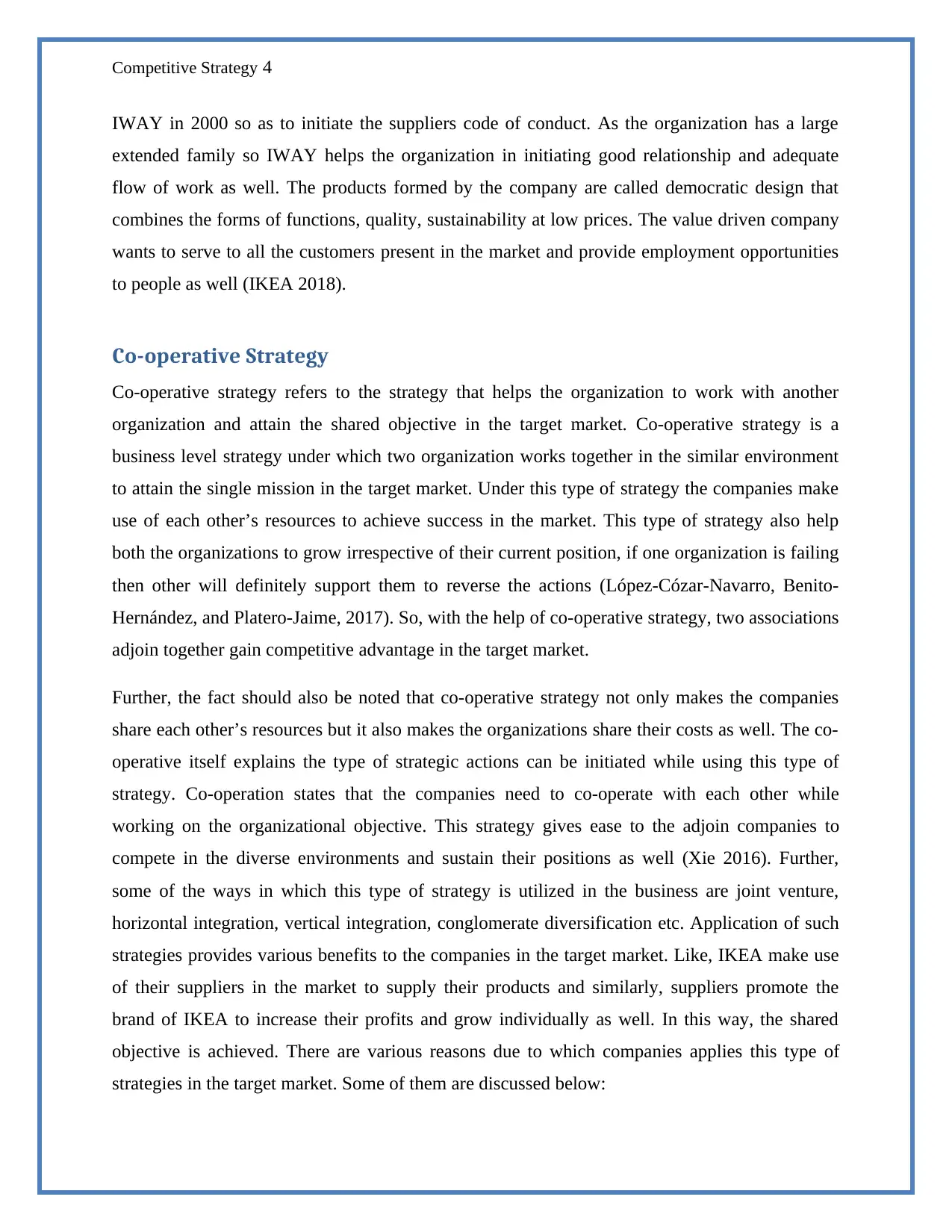
Competitive Strategy 4
IWAY in 2000 so as to initiate the suppliers code of conduct. As the organization has a large
extended family so IWAY helps the organization in initiating good relationship and adequate
flow of work as well. The products formed by the company are called democratic design that
combines the forms of functions, quality, sustainability at low prices. The value driven company
wants to serve to all the customers present in the market and provide employment opportunities
to people as well (IKEA 2018).
Co-operative Strategy
Co-operative strategy refers to the strategy that helps the organization to work with another
organization and attain the shared objective in the target market. Co-operative strategy is a
business level strategy under which two organization works together in the similar environment
to attain the single mission in the target market. Under this type of strategy the companies make
use of each other’s resources to achieve success in the market. This type of strategy also help
both the organizations to grow irrespective of their current position, if one organization is failing
then other will definitely support them to reverse the actions (López-Cózar-Navarro, Benito-
Hernández, and Platero-Jaime, 2017). So, with the help of co-operative strategy, two associations
adjoin together gain competitive advantage in the target market.
Further, the fact should also be noted that co-operative strategy not only makes the companies
share each other’s resources but it also makes the organizations share their costs as well. The co-
operative itself explains the type of strategic actions can be initiated while using this type of
strategy. Co-operation states that the companies need to co-operate with each other while
working on the organizational objective. This strategy gives ease to the adjoin companies to
compete in the diverse environments and sustain their positions as well (Xie 2016). Further,
some of the ways in which this type of strategy is utilized in the business are joint venture,
horizontal integration, vertical integration, conglomerate diversification etc. Application of such
strategies provides various benefits to the companies in the target market. Like, IKEA make use
of their suppliers in the market to supply their products and similarly, suppliers promote the
brand of IKEA to increase their profits and grow individually as well. In this way, the shared
objective is achieved. There are various reasons due to which companies applies this type of
strategies in the target market. Some of them are discussed below:
IWAY in 2000 so as to initiate the suppliers code of conduct. As the organization has a large
extended family so IWAY helps the organization in initiating good relationship and adequate
flow of work as well. The products formed by the company are called democratic design that
combines the forms of functions, quality, sustainability at low prices. The value driven company
wants to serve to all the customers present in the market and provide employment opportunities
to people as well (IKEA 2018).
Co-operative Strategy
Co-operative strategy refers to the strategy that helps the organization to work with another
organization and attain the shared objective in the target market. Co-operative strategy is a
business level strategy under which two organization works together in the similar environment
to attain the single mission in the target market. Under this type of strategy the companies make
use of each other’s resources to achieve success in the market. This type of strategy also help
both the organizations to grow irrespective of their current position, if one organization is failing
then other will definitely support them to reverse the actions (López-Cózar-Navarro, Benito-
Hernández, and Platero-Jaime, 2017). So, with the help of co-operative strategy, two associations
adjoin together gain competitive advantage in the target market.
Further, the fact should also be noted that co-operative strategy not only makes the companies
share each other’s resources but it also makes the organizations share their costs as well. The co-
operative itself explains the type of strategic actions can be initiated while using this type of
strategy. Co-operation states that the companies need to co-operate with each other while
working on the organizational objective. This strategy gives ease to the adjoin companies to
compete in the diverse environments and sustain their positions as well (Xie 2016). Further,
some of the ways in which this type of strategy is utilized in the business are joint venture,
horizontal integration, vertical integration, conglomerate diversification etc. Application of such
strategies provides various benefits to the companies in the target market. Like, IKEA make use
of their suppliers in the market to supply their products and similarly, suppliers promote the
brand of IKEA to increase their profits and grow individually as well. In this way, the shared
objective is achieved. There are various reasons due to which companies applies this type of
strategies in the target market. Some of them are discussed below:
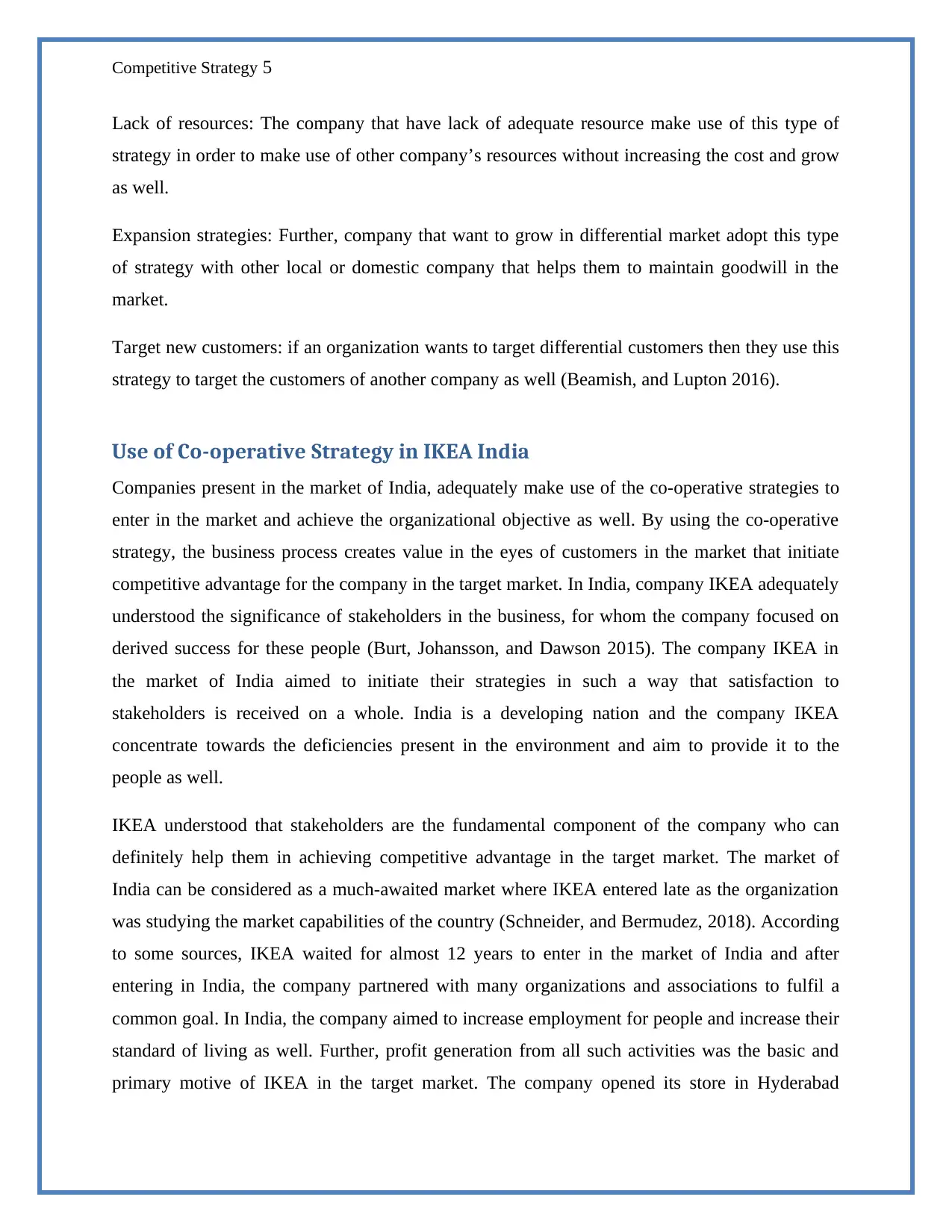
Competitive Strategy 5
Lack of resources: The company that have lack of adequate resource make use of this type of
strategy in order to make use of other company’s resources without increasing the cost and grow
as well.
Expansion strategies: Further, company that want to grow in differential market adopt this type
of strategy with other local or domestic company that helps them to maintain goodwill in the
market.
Target new customers: if an organization wants to target differential customers then they use this
strategy to target the customers of another company as well (Beamish, and Lupton 2016).
Use of Co-operative Strategy in IKEA India
Companies present in the market of India, adequately make use of the co-operative strategies to
enter in the market and achieve the organizational objective as well. By using the co-operative
strategy, the business process creates value in the eyes of customers in the market that initiate
competitive advantage for the company in the target market. In India, company IKEA adequately
understood the significance of stakeholders in the business, for whom the company focused on
derived success for these people (Burt, Johansson, and Dawson 2015). The company IKEA in
the market of India aimed to initiate their strategies in such a way that satisfaction to
stakeholders is received on a whole. India is a developing nation and the company IKEA
concentrate towards the deficiencies present in the environment and aim to provide it to the
people as well.
IKEA understood that stakeholders are the fundamental component of the company who can
definitely help them in achieving competitive advantage in the target market. The market of
India can be considered as a much-awaited market where IKEA entered late as the organization
was studying the market capabilities of the country (Schneider, and Bermudez, 2018). According
to some sources, IKEA waited for almost 12 years to enter in the market of India and after
entering in India, the company partnered with many organizations and associations to fulfil a
common goal. In India, the company aimed to increase employment for people and increase their
standard of living as well. Further, profit generation from all such activities was the basic and
primary motive of IKEA in the target market. The company opened its store in Hyderabad
Lack of resources: The company that have lack of adequate resource make use of this type of
strategy in order to make use of other company’s resources without increasing the cost and grow
as well.
Expansion strategies: Further, company that want to grow in differential market adopt this type
of strategy with other local or domestic company that helps them to maintain goodwill in the
market.
Target new customers: if an organization wants to target differential customers then they use this
strategy to target the customers of another company as well (Beamish, and Lupton 2016).
Use of Co-operative Strategy in IKEA India
Companies present in the market of India, adequately make use of the co-operative strategies to
enter in the market and achieve the organizational objective as well. By using the co-operative
strategy, the business process creates value in the eyes of customers in the market that initiate
competitive advantage for the company in the target market. In India, company IKEA adequately
understood the significance of stakeholders in the business, for whom the company focused on
derived success for these people (Burt, Johansson, and Dawson 2015). The company IKEA in
the market of India aimed to initiate their strategies in such a way that satisfaction to
stakeholders is received on a whole. India is a developing nation and the company IKEA
concentrate towards the deficiencies present in the environment and aim to provide it to the
people as well.
IKEA understood that stakeholders are the fundamental component of the company who can
definitely help them in achieving competitive advantage in the target market. The market of
India can be considered as a much-awaited market where IKEA entered late as the organization
was studying the market capabilities of the country (Schneider, and Bermudez, 2018). According
to some sources, IKEA waited for almost 12 years to enter in the market of India and after
entering in India, the company partnered with many organizations and associations to fulfil a
common goal. In India, the company aimed to increase employment for people and increase their
standard of living as well. Further, profit generation from all such activities was the basic and
primary motive of IKEA in the target market. The company opened its store in Hyderabad
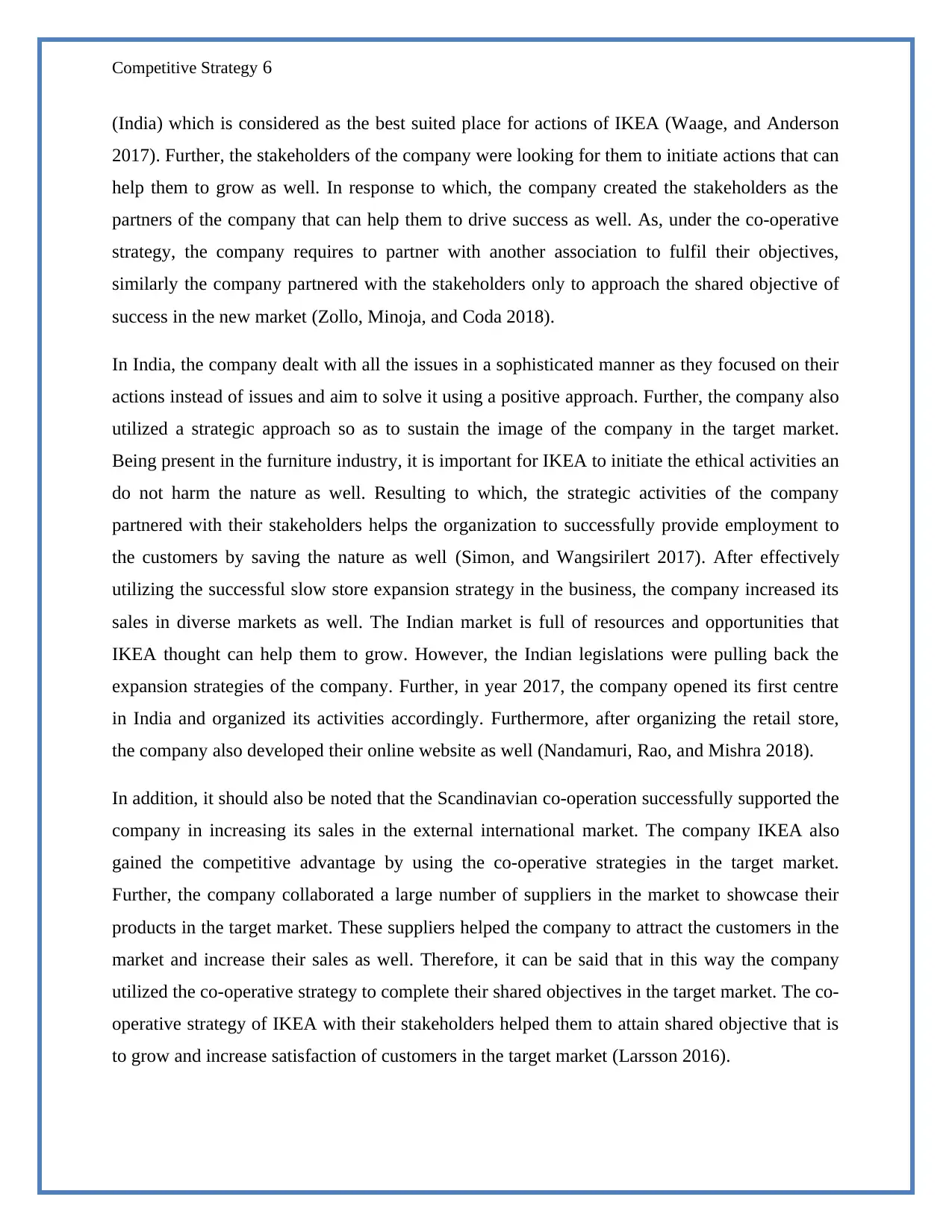
Competitive Strategy 6
(India) which is considered as the best suited place for actions of IKEA (Waage, and Anderson
2017). Further, the stakeholders of the company were looking for them to initiate actions that can
help them to grow as well. In response to which, the company created the stakeholders as the
partners of the company that can help them to drive success as well. As, under the co-operative
strategy, the company requires to partner with another association to fulfil their objectives,
similarly the company partnered with the stakeholders only to approach the shared objective of
success in the new market (Zollo, Minoja, and Coda 2018).
In India, the company dealt with all the issues in a sophisticated manner as they focused on their
actions instead of issues and aim to solve it using a positive approach. Further, the company also
utilized a strategic approach so as to sustain the image of the company in the target market.
Being present in the furniture industry, it is important for IKEA to initiate the ethical activities an
do not harm the nature as well. Resulting to which, the strategic activities of the company
partnered with their stakeholders helps the organization to successfully provide employment to
the customers by saving the nature as well (Simon, and Wangsirilert 2017). After effectively
utilizing the successful slow store expansion strategy in the business, the company increased its
sales in diverse markets as well. The Indian market is full of resources and opportunities that
IKEA thought can help them to grow. However, the Indian legislations were pulling back the
expansion strategies of the company. Further, in year 2017, the company opened its first centre
in India and organized its activities accordingly. Furthermore, after organizing the retail store,
the company also developed their online website as well (Nandamuri, Rao, and Mishra 2018).
In addition, it should also be noted that the Scandinavian co-operation successfully supported the
company in increasing its sales in the external international market. The company IKEA also
gained the competitive advantage by using the co-operative strategies in the target market.
Further, the company collaborated a large number of suppliers in the market to showcase their
products in the target market. These suppliers helped the company to attract the customers in the
market and increase their sales as well. Therefore, it can be said that in this way the company
utilized the co-operative strategy to complete their shared objectives in the target market. The co-
operative strategy of IKEA with their stakeholders helped them to attain shared objective that is
to grow and increase satisfaction of customers in the target market (Larsson 2016).
(India) which is considered as the best suited place for actions of IKEA (Waage, and Anderson
2017). Further, the stakeholders of the company were looking for them to initiate actions that can
help them to grow as well. In response to which, the company created the stakeholders as the
partners of the company that can help them to drive success as well. As, under the co-operative
strategy, the company requires to partner with another association to fulfil their objectives,
similarly the company partnered with the stakeholders only to approach the shared objective of
success in the new market (Zollo, Minoja, and Coda 2018).
In India, the company dealt with all the issues in a sophisticated manner as they focused on their
actions instead of issues and aim to solve it using a positive approach. Further, the company also
utilized a strategic approach so as to sustain the image of the company in the target market.
Being present in the furniture industry, it is important for IKEA to initiate the ethical activities an
do not harm the nature as well. Resulting to which, the strategic activities of the company
partnered with their stakeholders helps the organization to successfully provide employment to
the customers by saving the nature as well (Simon, and Wangsirilert 2017). After effectively
utilizing the successful slow store expansion strategy in the business, the company increased its
sales in diverse markets as well. The Indian market is full of resources and opportunities that
IKEA thought can help them to grow. However, the Indian legislations were pulling back the
expansion strategies of the company. Further, in year 2017, the company opened its first centre
in India and organized its activities accordingly. Furthermore, after organizing the retail store,
the company also developed their online website as well (Nandamuri, Rao, and Mishra 2018).
In addition, it should also be noted that the Scandinavian co-operation successfully supported the
company in increasing its sales in the external international market. The company IKEA also
gained the competitive advantage by using the co-operative strategies in the target market.
Further, the company collaborated a large number of suppliers in the market to showcase their
products in the target market. These suppliers helped the company to attract the customers in the
market and increase their sales as well. Therefore, it can be said that in this way the company
utilized the co-operative strategy to complete their shared objectives in the target market. The co-
operative strategy of IKEA with their stakeholders helped them to attain shared objective that is
to grow and increase satisfaction of customers in the target market (Larsson 2016).
Paraphrase This Document
Need a fresh take? Get an instant paraphrase of this document with our AI Paraphraser
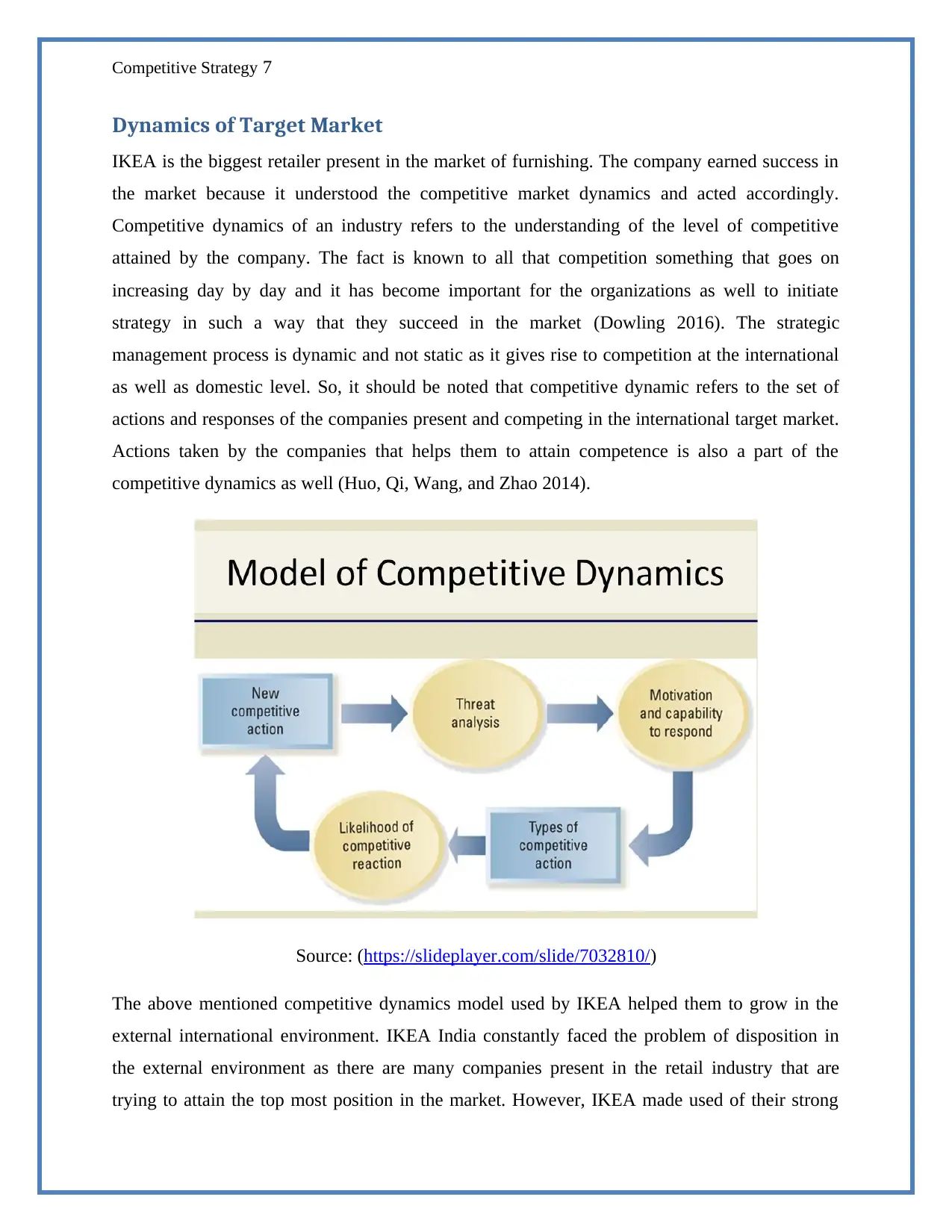
Competitive Strategy 7
Dynamics of Target Market
IKEA is the biggest retailer present in the market of furnishing. The company earned success in
the market because it understood the competitive market dynamics and acted accordingly.
Competitive dynamics of an industry refers to the understanding of the level of competitive
attained by the company. The fact is known to all that competition something that goes on
increasing day by day and it has become important for the organizations as well to initiate
strategy in such a way that they succeed in the market (Dowling 2016). The strategic
management process is dynamic and not static as it gives rise to competition at the international
as well as domestic level. So, it should be noted that competitive dynamic refers to the set of
actions and responses of the companies present and competing in the international target market.
Actions taken by the companies that helps them to attain competence is also a part of the
competitive dynamics as well (Huo, Qi, Wang, and Zhao 2014).
Source: (https://slideplayer.com/slide/7032810/)
The above mentioned competitive dynamics model used by IKEA helped them to grow in the
external international environment. IKEA India constantly faced the problem of disposition in
the external environment as there are many companies present in the retail industry that are
trying to attain the top most position in the market. However, IKEA made used of their strong
Dynamics of Target Market
IKEA is the biggest retailer present in the market of furnishing. The company earned success in
the market because it understood the competitive market dynamics and acted accordingly.
Competitive dynamics of an industry refers to the understanding of the level of competitive
attained by the company. The fact is known to all that competition something that goes on
increasing day by day and it has become important for the organizations as well to initiate
strategy in such a way that they succeed in the market (Dowling 2016). The strategic
management process is dynamic and not static as it gives rise to competition at the international
as well as domestic level. So, it should be noted that competitive dynamic refers to the set of
actions and responses of the companies present and competing in the international target market.
Actions taken by the companies that helps them to attain competence is also a part of the
competitive dynamics as well (Huo, Qi, Wang, and Zhao 2014).
Source: (https://slideplayer.com/slide/7032810/)
The above mentioned competitive dynamics model used by IKEA helped them to grow in the
external international environment. IKEA India constantly faced the problem of disposition in
the external environment as there are many companies present in the retail industry that are
trying to attain the top most position in the market. However, IKEA made used of their strong
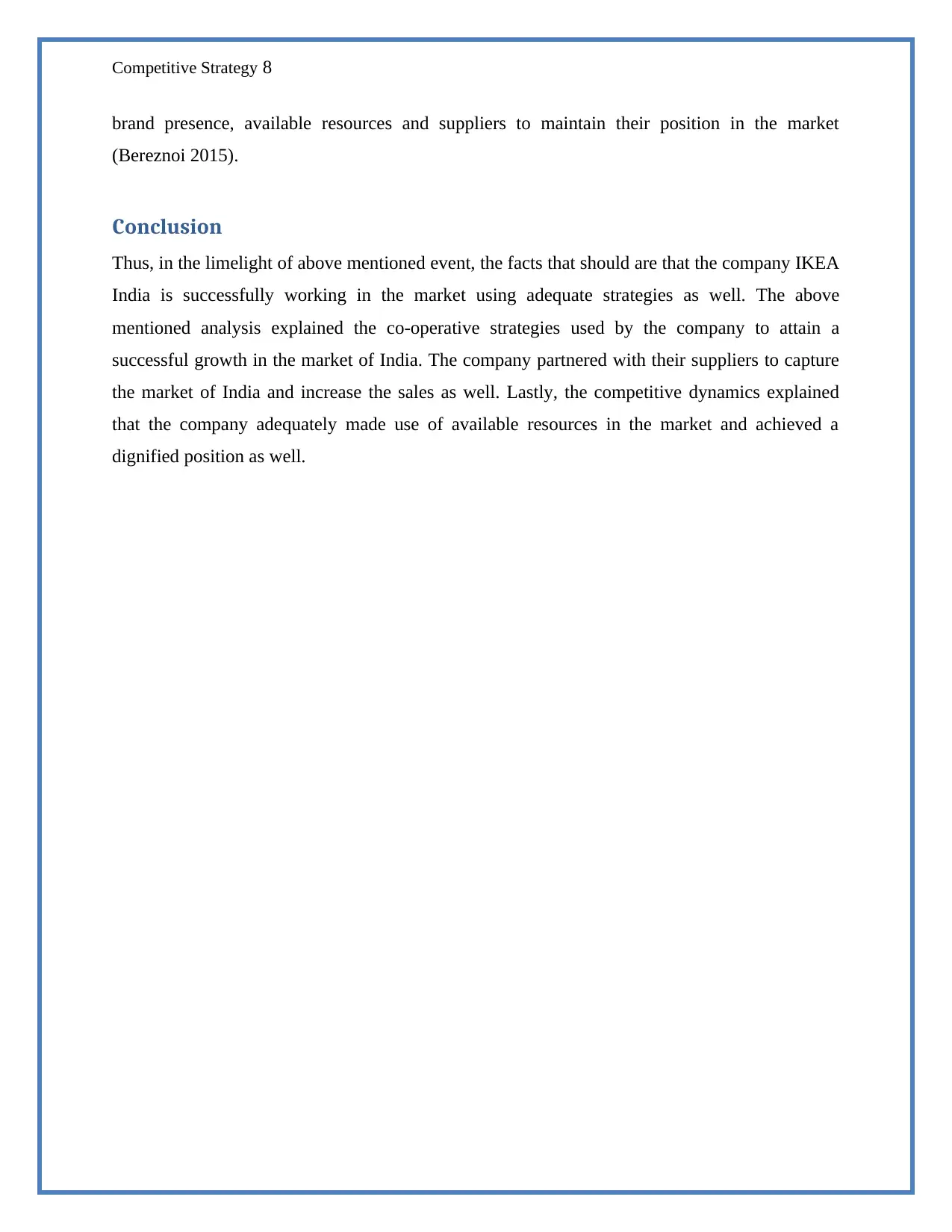
Competitive Strategy 8
brand presence, available resources and suppliers to maintain their position in the market
(Bereznoi 2015).
Conclusion
Thus, in the limelight of above mentioned event, the facts that should are that the company IKEA
India is successfully working in the market using adequate strategies as well. The above
mentioned analysis explained the co-operative strategies used by the company to attain a
successful growth in the market of India. The company partnered with their suppliers to capture
the market of India and increase the sales as well. Lastly, the competitive dynamics explained
that the company adequately made use of available resources in the market and achieved a
dignified position as well.
brand presence, available resources and suppliers to maintain their position in the market
(Bereznoi 2015).
Conclusion
Thus, in the limelight of above mentioned event, the facts that should are that the company IKEA
India is successfully working in the market using adequate strategies as well. The above
mentioned analysis explained the co-operative strategies used by the company to attain a
successful growth in the market of India. The company partnered with their suppliers to capture
the market of India and increase the sales as well. Lastly, the competitive dynamics explained
that the company adequately made use of available resources in the market and achieved a
dignified position as well.
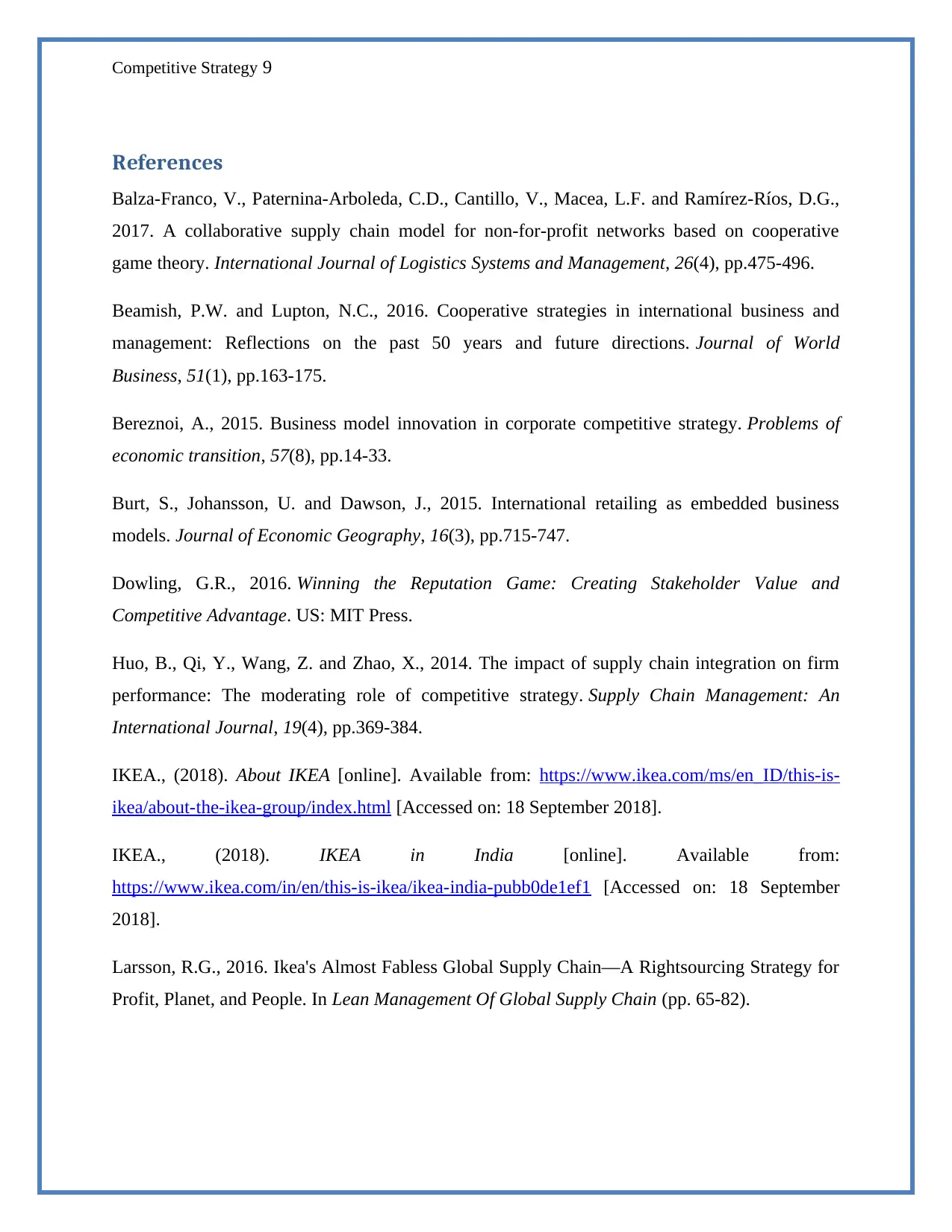
Competitive Strategy 9
References
Balza-Franco, V., Paternina-Arboleda, C.D., Cantillo, V., Macea, L.F. and Ramírez-Ríos, D.G.,
2017. A collaborative supply chain model for non-for-profit networks based on cooperative
game theory. International Journal of Logistics Systems and Management, 26(4), pp.475-496.
Beamish, P.W. and Lupton, N.C., 2016. Cooperative strategies in international business and
management: Reflections on the past 50 years and future directions. Journal of World
Business, 51(1), pp.163-175.
Bereznoi, A., 2015. Business model innovation in corporate competitive strategy. Problems of
economic transition, 57(8), pp.14-33.
Burt, S., Johansson, U. and Dawson, J., 2015. International retailing as embedded business
models. Journal of Economic Geography, 16(3), pp.715-747.
Dowling, G.R., 2016. Winning the Reputation Game: Creating Stakeholder Value and
Competitive Advantage. US: MIT Press.
Huo, B., Qi, Y., Wang, Z. and Zhao, X., 2014. The impact of supply chain integration on firm
performance: The moderating role of competitive strategy. Supply Chain Management: An
International Journal, 19(4), pp.369-384.
IKEA., (2018). About IKEA [online]. Available from: https://www.ikea.com/ms/en_ID/this-is-
ikea/about-the-ikea-group/index.html [Accessed on: 18 September 2018].
IKEA., (2018). IKEA in India [online]. Available from:
https://www.ikea.com/in/en/this-is-ikea/ikea-india-pubb0de1ef1 [Accessed on: 18 September
2018].
Larsson, R.G., 2016. Ikea's Almost Fabless Global Supply Chain—A Rightsourcing Strategy for
Profit, Planet, and People. In Lean Management Of Global Supply Chain (pp. 65-82).
References
Balza-Franco, V., Paternina-Arboleda, C.D., Cantillo, V., Macea, L.F. and Ramírez-Ríos, D.G.,
2017. A collaborative supply chain model for non-for-profit networks based on cooperative
game theory. International Journal of Logistics Systems and Management, 26(4), pp.475-496.
Beamish, P.W. and Lupton, N.C., 2016. Cooperative strategies in international business and
management: Reflections on the past 50 years and future directions. Journal of World
Business, 51(1), pp.163-175.
Bereznoi, A., 2015. Business model innovation in corporate competitive strategy. Problems of
economic transition, 57(8), pp.14-33.
Burt, S., Johansson, U. and Dawson, J., 2015. International retailing as embedded business
models. Journal of Economic Geography, 16(3), pp.715-747.
Dowling, G.R., 2016. Winning the Reputation Game: Creating Stakeholder Value and
Competitive Advantage. US: MIT Press.
Huo, B., Qi, Y., Wang, Z. and Zhao, X., 2014. The impact of supply chain integration on firm
performance: The moderating role of competitive strategy. Supply Chain Management: An
International Journal, 19(4), pp.369-384.
IKEA., (2018). About IKEA [online]. Available from: https://www.ikea.com/ms/en_ID/this-is-
ikea/about-the-ikea-group/index.html [Accessed on: 18 September 2018].
IKEA., (2018). IKEA in India [online]. Available from:
https://www.ikea.com/in/en/this-is-ikea/ikea-india-pubb0de1ef1 [Accessed on: 18 September
2018].
Larsson, R.G., 2016. Ikea's Almost Fabless Global Supply Chain—A Rightsourcing Strategy for
Profit, Planet, and People. In Lean Management Of Global Supply Chain (pp. 65-82).
Secure Best Marks with AI Grader
Need help grading? Try our AI Grader for instant feedback on your assignments.
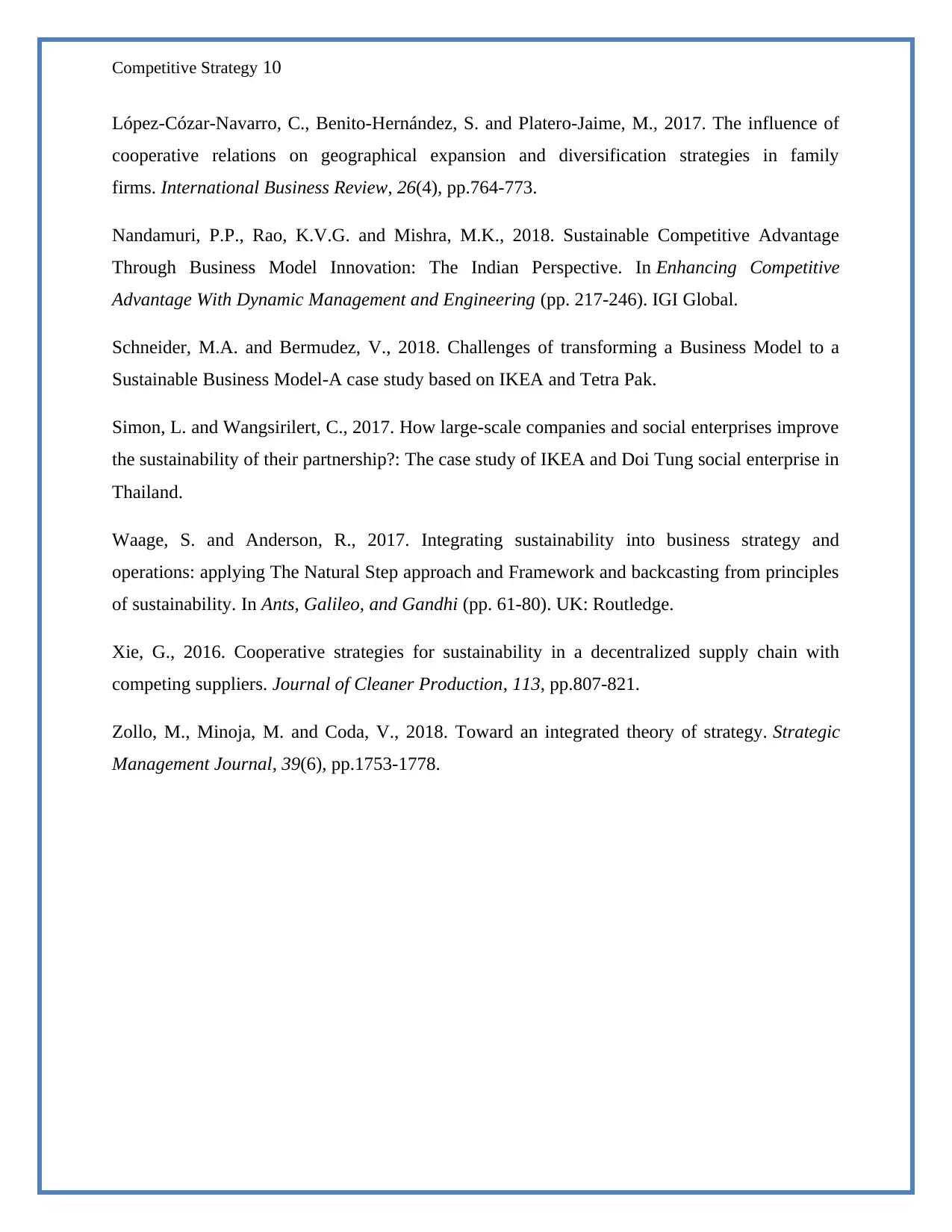
Competitive Strategy 10
López-Cózar-Navarro, C., Benito-Hernández, S. and Platero-Jaime, M., 2017. The influence of
cooperative relations on geographical expansion and diversification strategies in family
firms. International Business Review, 26(4), pp.764-773.
Nandamuri, P.P., Rao, K.V.G. and Mishra, M.K., 2018. Sustainable Competitive Advantage
Through Business Model Innovation: The Indian Perspective. In Enhancing Competitive
Advantage With Dynamic Management and Engineering (pp. 217-246). IGI Global.
Schneider, M.A. and Bermudez, V., 2018. Challenges of transforming a Business Model to a
Sustainable Business Model-A case study based on IKEA and Tetra Pak.
Simon, L. and Wangsirilert, C., 2017. How large-scale companies and social enterprises improve
the sustainability of their partnership?: The case study of IKEA and Doi Tung social enterprise in
Thailand.
Waage, S. and Anderson, R., 2017. Integrating sustainability into business strategy and
operations: applying The Natural Step approach and Framework and backcasting from principles
of sustainability. In Ants, Galileo, and Gandhi (pp. 61-80). UK: Routledge.
Xie, G., 2016. Cooperative strategies for sustainability in a decentralized supply chain with
competing suppliers. Journal of Cleaner Production, 113, pp.807-821.
Zollo, M., Minoja, M. and Coda, V., 2018. Toward an integrated theory of strategy. Strategic
Management Journal, 39(6), pp.1753-1778.
López-Cózar-Navarro, C., Benito-Hernández, S. and Platero-Jaime, M., 2017. The influence of
cooperative relations on geographical expansion and diversification strategies in family
firms. International Business Review, 26(4), pp.764-773.
Nandamuri, P.P., Rao, K.V.G. and Mishra, M.K., 2018. Sustainable Competitive Advantage
Through Business Model Innovation: The Indian Perspective. In Enhancing Competitive
Advantage With Dynamic Management and Engineering (pp. 217-246). IGI Global.
Schneider, M.A. and Bermudez, V., 2018. Challenges of transforming a Business Model to a
Sustainable Business Model-A case study based on IKEA and Tetra Pak.
Simon, L. and Wangsirilert, C., 2017. How large-scale companies and social enterprises improve
the sustainability of their partnership?: The case study of IKEA and Doi Tung social enterprise in
Thailand.
Waage, S. and Anderson, R., 2017. Integrating sustainability into business strategy and
operations: applying The Natural Step approach and Framework and backcasting from principles
of sustainability. In Ants, Galileo, and Gandhi (pp. 61-80). UK: Routledge.
Xie, G., 2016. Cooperative strategies for sustainability in a decentralized supply chain with
competing suppliers. Journal of Cleaner Production, 113, pp.807-821.
Zollo, M., Minoja, M. and Coda, V., 2018. Toward an integrated theory of strategy. Strategic
Management Journal, 39(6), pp.1753-1778.
1 out of 11
Related Documents
Your All-in-One AI-Powered Toolkit for Academic Success.
+13062052269
info@desklib.com
Available 24*7 on WhatsApp / Email
![[object Object]](/_next/static/media/star-bottom.7253800d.svg)
Unlock your academic potential
© 2024 | Zucol Services PVT LTD | All rights reserved.





